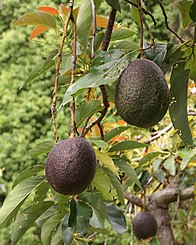Avocado oil
| Avocado oil | |
|---|---|
| Raw material plant (noun) |
Avocado tree ( Persea americana ) |
| origin |
Pulp |
| colour |
dark yellow-brown, greenish |
| ingredients | |
| Oleic acid | 42-64% |
| Linoleic acid | 7-17% |
| Linolenic acid | <1.2% |
| Palmitic acid | 16-28% |
| Myristic acid | 1.5-2.5% |
| More fatty acids | Stearic acid <1.5%, palmitoleic acid 5–10%, asclepic acid ( cis -vaccenic acid) 3.5–7% |
| properties | |
| density | 0.908-0.921 kg / l (at 25 ° C) |
| viscosity | = 62 mPas (at 25 ° C) |
| Oxidation stability | 10.5-13.5 hours (cold pressed); up to 116 h (dried pulp) |
| Melting point | 7-9 ° C |
| Iodine number | 65-95 |
| Saponification number | 170-197 |
| Manufacturing and Consumption | |
| Most important production countries | Mexico , Dominican Republic , Indonesia , Colombia , Peru |
| use | Edible oil and cosmetics |
Avocado oil is a vegetable oil that is extracted from the fruits of the avocado tree ( Persea americana ). Like olive oil, it is a pulp oil , the mesocarp contains up to 30% fat, the fat content of the different cultivars fluctuating greatly.
Manufacturing
Avocado oil is usually obtained from the pulp by cold pressing (Avocado oleum virginale); extraction can also be supported enzymatically or the oil can be hot-pressed and extracted using solvents . Refined avocado oil (Avocado oleum raffinatum) is light in color and rather clear. The remaining press cake is used as animal feed .
Other extraction methods are also used.
composition
Avocado oil is a triglyceride , i.e. a mixture of many triesters of glycerine with varying proportions of fatty acid residues. Of the fatty acid residues, the oleic acid residue dominates with a share of around 52%.
The slightly cloudy avocado oil is dark yellow-brown, greenish and smells fruity-lovely, slightly musty and sour. The greenish cloudiness is caused by the high content of pigments ( chlorophyll , carotenoids ). Like all oils of vegetable origin, avocado oil also contains phytosterols , especially β-sitosterol .
The smoke point of the refined oil is over 250 ° C.
use
It serves as a flavoring cooking oil . It is also used to make skin care products.
Individual evidence
- ↑ a b c d e f g h i Sabine Krist: Lexicon of vegetable fats and oils. Springer Verlag, Vienna 2013, ISBN 978-3-7091-1004-1 , pp. 99-105.
- ↑ a b c d e J. Schormüller : Handbuch der Lebensmittelchemie. Volume IV: Fette und Lipoide (Lipids) , Springer, 1969, ISBN 978-3-662-23548-5 (Reprint), p. 22 f.
- ↑ a b Luthfia Indriyani, Abdul Rohman, Sugeng Riyanto: Physico-Chemical Characterization of avocado (. Persea americana Mill) Oil from Three Indonesian avocado cultivars. In: Research Journal of Medicinal Plants. 10, 2015, pp. 67-78, doi: 10.3923 / rjmp.2016.67.78 .
- ↑ a b Nathalie Vingering, Marine Oseredczuk et al .: Fatty acid composition of commercial vegetable oils from the French market analyzed using a long highly polar column. In: OCL. 17 (3), 2010, pp. 185-192, doi: 10.1051 / ocl.2010.0309 , (PDF).
- ^ A b Y. Lozano: Analysis of triglycerides in the avocado oil by reversed-phase high-performance liquidchromatography — scientific report. In: Revue Francaise Des Corps Gras. 30, 1983, pp. 333-346.
- ^ Walter E. Farr, Andrew Proctor: Green Vegetable Oil Processing. Revised First Edition, AOCS Press, 2014, ISBN 978-0-9888565-3-0 , pp. 37-45.
- ↑ Isabelle Santana, Alexandre Guedes Torres et al .: Oxidative Stability of Avocado Pulp Oil Obtained by Different Processes. Universidade Federal do Rio de Janeiro, 2011, online (PDF), at embrapa.br, accessed on November 18, 2017.
- ^ Ullmann's Food and Feed. Vol. 2, Wiley, 2017, ISBN 978-3-527-33990-7 , p. 703.
- ↑ FAO statistics 2014 .
- ^ Leon A. Terry: Health-promoting Properties of Fruits and Vegetables. CABI 2011, ISBN 978-1-84593-528-3 , p. 35.
- ↑ a b Frank D. Gunstone: Vegetable Oils in Food Technology. Second Edition, Wiley-Blackwell, 2011, ISBN 978-1-4443-3268-1 , p. 315 f.
- ↑ Smain Chemat: Edible Oils: Extraction, Processing, and Applications. CRC Press, 2017, ISBN 978-1-351-64853-0 .
- ↑ Rudolf Hänsel, Otto Sticher: Pharmakognosie - Phytopharmazie. 9th edition, Springer, 2010, ISBN 978-3-642-00962-4 , pp. 701 f.
- ^ Giacomo Costagli, Matteo Betti: Avocado Oil Extraction Processes: Method for Cold-Pressed High-Quality Edible Oil Production versus Traditional Production. In: J. Agr. Closely. Vol. 46, no. 3, 2015, pp. 115–122, doi: 10.4081 / jae.2015.467 .
- ↑ M. Flores, C. Saravia, CE Vergara et al .: Avocado Oil: Characteristics, Properties, and Applications. In: Molecules. 24 (11), 2019, p. 2172, doi: 10.3390 / molecules24112172 .
- ↑ X. Qin, J. Zhong: A Review of Extraction Techniques for Avocado Oil. In: J. Oleo Sci. 65 (11) 2016, pp. 881-888, PMID 27725362 , doi : 10.5650 / jos.ess16063 .
- ^ Marie Wong; Cecilia Requejo-Jackman; Allan Woolf: "What is unrefined, extra virgin cold-pressed avocado oil?" In: The American Oil Chemists' Society. April 04, 2010, on aocs.org, accessed March 9, 2020.



